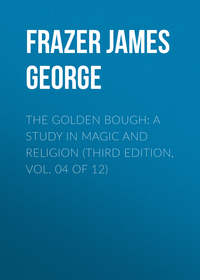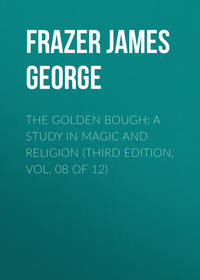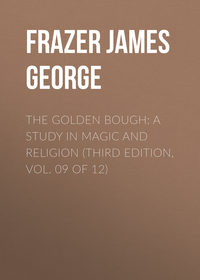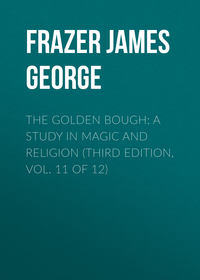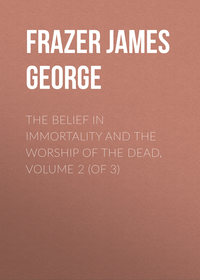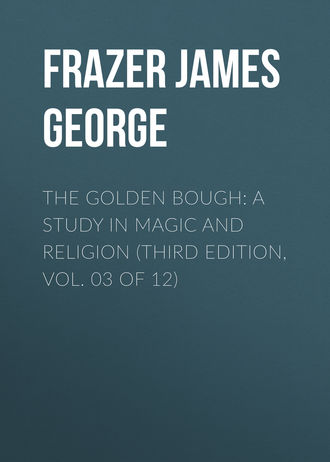 полная версия
полная версияThe Golden Bough: A Study in Magic and Religion (Third Edition, Vol. 03 of 12)
1534
A. C. Kruijt, “Een en ander aangaande het geestelijk en maatschappelijk leven van den Poso-Alfoer,” Mededeelingen van wege het Nederlandsche Zendelinggenootschap, xxxix. (1895) pp. 146-148; id., “Eenige ethnografische aanteekeningen omtrent de Toboengkoe en de Tomori,” ibid. xliv. (1900) pp. 228 sq.
1535
N. Adriani und A. C. Kruijt, “Van Posso naar Mori,” Mededeelingen van wege het Nederlandsche Zendelinggenootschap, xliv. (1900) pp. 145 sq.
1536
A. C. Kruijt, “Regen lokken en regen verdrijven bij de Toradja's van Midden Celebes,” Tijdschrift voor Indische Taal- Land- en Volkenkunde, xliv. (1901) p. 8; id., “Het rijk Mori,” Tijdschrift van het Koniklijk Nederlandsch Aardrijkskundig Genootschap, II. Serie, xvii. (1900) p. 464, note.
1537
B. F. Matthes, Bijdragen tot de Ethnologie van Zuid-Celebes (The Hague, 1875), p. 107; id., “Over de âdá's of gewoonten der Makassaren en Boegineezen,” Verslagen en Mededeelingen der Koninklijke Akademie van Wetenschappen, Afdeeling Letterkunde, III. Reeks, ii. (Amsterdam, 1885) pp. 164 sq.
1538
H. E. D. Engelhard, “Mededeelingen over het eiland Saleijer,” Bijdragen tot de Taal- Land- en Volkenkunde van Neêrlandsch-Indië, Vierde Volgreeks, viii. (1884) p. 369.
1539
E. F. Jochim, “Beschrijving van den Sapoedi Archipel,” Tijdschrift voor Indische Taal- Land- en Volkenkunde, xxxvi. (1893) p. 361.
1540
M. J. van Baarda, “Fabelen, Verhalen en Overleveringen der Galelareezen,” Bijdragen tot de Taal- Land- en Volkenkunde van Nederlandsch-Indië, xlv. (1895) p. 508.
1541
S. D. van de Velde van Cappellan, “Verslag eener Bezoekreis naar de Sangi-eilanden,” Mededeelingen van wege het Nederlandsche Zendelinggenootschap, i. (1857) pp. 33, 35.
1542
A. C. Kruijt, “Een en ander aangaande het geestelijk en maatschappelijk leven van den Poso-Alfoer,” Mededeelingen van wege het Nederlandsche Zendelinggenootschap, xxxix. (1895) p. 148.
1543
Th. J. F. van Hasselt, “Gebruik van vermomde Taal door de Nufooren,” Tijdschrift voor Indische Taal- Land- en Volkenkunde, xlv. (1902) pp. 279 sq.
1544
K. F. Holle, “Snippers van den Regent van Galoeh,” Tijdschrift voor Indische Taal- Land- en Volkenkunde, xxvii. (1882) pp. 101 sq.
1545
Ch. Hose and W. McDougall, “The Relations between Men and Animals in Sarawak,” Journal of the Anthropological Institute, xxxi. (1902) p. 205; W. H. Furness, Home-life of Borneo Head-hunters (Philadelphia, 1902), pp. 17, 186 sq.
1546
Ch. Hose and W. McDougall, op. cit. p. 186.
1547
Ch. Brooke, Ten Years in Sarawak (London, 1866), i. 208; Spenser St. John, Life in the Forests of the Far East,2 i. 71 sq.
1548
Juan de la Concepcion, Historia general de Philipinas, i. (Manilla, 1788), p. 20. Compare J. Mallat, Les Philippines (Paris, 1846), i. 64.
1549
On this subject Mr. R. J. Wilkinson's account of the Malay's attitude to nature (Malay Beliefs, London and Leyden, 1906, pp. 67 sq.) deserves to be quoted: “The practice of magic arts enters into every department of Malay life. If (as the people of the Peninsula believe) all nature is teeming with spiritual life, some spiritual weapon is necessary to protect man against possible ghostly foes. Now the chief and most characteristic weapon of the Malay in his fight against the invisible world is courtesy. The peasant will speak no evil of a tiger in the jungle or of an evil spirit within the limits of that spirit's authority… The tiger is the symbol of kingly oppression; still, he is royal and must not be insulted; he is the ‘shaggy-haired father’ or ‘grandfather’ of the traveller in the woods. Even the birds, the fish and the fruits that serve as human food are entitled to a certain consideration: the deer is addressed as a ‘prince,’ the coco-nut tree as a ‘princess,’ the chevrotin as ‘emperor of the jungle’ (shah alam di-rimba). In all this respect paid to unseen powers – for it is the soul of the animal or plant that is feared – there is no contemptible adulation or cringeing; the Malay believes that courtesy honours the speaker more than the person addressed.”
1550
The character of King Solomon appears to be a favourite one with the Malay sorcerer when he desires to ingratiate himself with or lord it over the powers of nature. Thus, for example, in addressing silver ore the sage observes: —
“If you do not come hither at this very momentYou shall be a rebel unto God,And a rebel unto God's Prophet Solomon,For I am God's Prophet Solomon.” —
See W. W. Skeat, Malay Magic, p. 273. No doubt the fame of his wisdom has earned for the Hebrew monarch this distinction among the dusky wizards of the East.
1551
“The mind of the savage is not a blank; and when one becomes familiar with his beliefs and superstitions, and the complicated nature of his laws and customs, preconceived notions of his simplicity of thought go to the winds. I have yet to find that most apocryphal of beings described as the ‘unsophisticated African.’ We laugh at and ridicule his fetishes and superstitions, but we fail to follow the succession of ideas and effort of mind which have created these things. After most careful observations extending over nineteen years, I have come to the conclusion that there is nothing in the customs and fetishes of the African which does not represent a definite course of reasoning” (Rev. Thomas Lewis, “The Ancient Kingdom of Kongo,” The Geographical Journal, xix. (1902) p. 554). “The study of primitive peoples is extremely curious and full of surprises. It is twenty years since I undertook it among the Thonga and Pedi tribes of South Africa, and the further I advance, the more I am astonished at the great number, the complexity, and the profundity of the rites of these so-called savages. Only a superficial observer could accuse their individual or tribal life of superficiality. If we take the trouble to seek the reason of these strange customs, we perceive that at their base there are secret, obscure reasons, principles hard to grasp, even though the most fervent adepts of the rite can give no account of it. To discover these principles, and so to give a true explanation of the rites, is the supreme task of the ethnographer, – a task in the highest degree delicate, for it is impossible to perform it if we do not lay aside our personal ideas to saturate ourselves with those of primitive peoples” (Rev. H. A. Junod, “Les Conceptions physiologiques des Bantou sud-africains et leurs tabous,” Revue d'Ethnographie et de Sociologie, i. (1910) p. 126). These weighty words, the fruit of ripe experience, deserve to be pondered by those who fancy that the elaborate system of savage custom can have grown up instinctively without a correspondingly elaborate process of reasoning in the minds of its founders. We may not, indeed, always be able to discover the reason for which a particular custom or rite was instituted, for we are only beginning to understand the mind of uncivilised man; but all that we know of him tends to shew that his practice, however absurd it may seem to us, originated in a definite train of thought and for a definite and very practical purpose.
1552
See above, pp. 159 sq.
1553
M. J. van Baarda, “Fabelen, Verhalen en Overleveringen der Galelareezen,” Bijdragen tot de Taal- Land- en Volkenkunde van Nederlandsch-Indië, xlv. (1895) p. 513.
1554
John Ramsay, Scotland and Scotsmen in the Eighteenth Century (Edinburgh, 1888), ii. 456.
1555
H. R. Schoolcraft, Indian Tribes, ii. 175.
1556
J. Macdonald, Light in Africa (London, 1890), p. 209.
1557
Rev. J. Roscoe, in Journal of the Anthropological Institute, xxxii. (1902) p. 59.
1558
A. C. Hollis, The Nandi, pp. 24 sq., 36. In these cases the harm is thought to fall on the person who steps over, not on the thing which is stepped over.
1559
Rev. J. H. Weeks, “Customs of the Lower Congo People,” Folk-lore, xx. (1909) p. 474.
1560
B. Gutmann, “Trauer und Begräbnissitten der Wadschagga,” Globus, lxxxix. (1906) p. 199.
1561
E. Aymonier, Voyage dans le Laos, i. (Paris, 1895) p. 144.
1562
C. Lumholtz, Unknown Mexico (London, 1903), i. 435.
1563
E. M. Curr, The Australian Race, i. 50.
1564
A. W. Howitt, Native Tribes of South-East Australia, p. 402.
1565
Father Lambert, Mœurs et superstitions des Néo-Calédoniens, pp. 192 sq.
1566
P. von Stenin, “Das Gewohnheitsrecht der Samojeden,” Globus, lx. (1891) p. 173.
1567
J. Richardson, in Antananarivo Annual and Madagascar Magazine, Reprint of the First Four Numbers (Antananarivo, 1885), p. 529; id., Reprint of the Second Four Numbers (Antananarivo, 1896), p. 296; J. Sibree, The Great African Island, p. 288; compare De Flacourt, Histoire de la grande isle Madagascar (Paris, 1658), p. 99.
1568
J. Mooney, “Myths of the Cherokee,” Nineteenth Annual Report of the Bureau of American Ethnology, pt. i. (Washington, 1900) p. 424.
1569
H. A. Junod, “Les Conceptions physiologiques des Bantou sud-africains,” Revue d'Ethnographie et de Sociologie, i. (1910) p. 138, note 3.
1570
F. S. Krauss, Volksglaube und religiöser Brauch der Südslaven, p. 52.
1571
See L. F. Sauvé, Folk-lore des Hautes-Vosges, p. 226, compare pp. 219 sq.; E. Monseur, Le Folk-lore Wallon, p. 39; A. Wuttke, Der deutsche Volksaberglaube,2 § 603; J. W. Wolf, Beiträge zur deutschen Mythologie, i. p. 208, § 42; J. A. E. Köhler, Volksbrauch, etc., im Voigtlande, p. 423; A. Kuhn und W. Schwartz, Norddeutsche Sagen, Märchen und Gebräuche, p. 462, § 461; E. Krause, “Abergläubische Kuren und sonstiger Aberglaube in Berlin,” Zeitschrift für Ethnologie, xv. (1883) p. 85; R. H. Kaindl, Die Huzulen, p. 5; J. V. Grohmann, Aberglauben und Gebräuche aus Böhmen und Mähren, p. 109, §§ 798, 799; Eijüb Abêla, “Beiträge zur Kenntniss abergläubischer Gebräuche in Syrien,” Zeitschrift des deutschen Palästina-Vereins, vii. (1884) p. 81; compare B. Chemali, “Naissance et premier âge au Liban,” Anthropos, v. (1910) p. 741.


